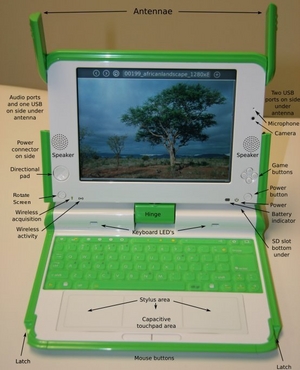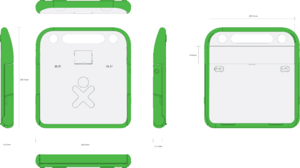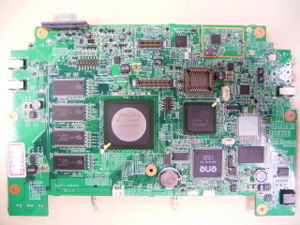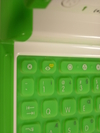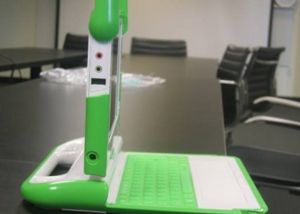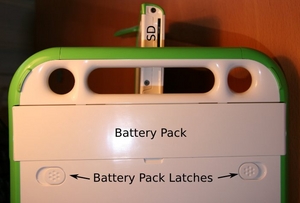Hardware specification: Difference between revisions
(USB on-the-go works in the chipset; why not in the laptop?) |
Aperezbios (talk | contribs) |
||
| (295 intermediate revisions by 62 users not shown) | |||
| Line 1: | Line 1: | ||
{{OLPC}} |
|||
=Hardware details for OLPC, 16 Feb. 2006= |
|||
{{Translations}} <!-- to add new translations edit [[Hardware design/translations]] --> |
|||
V. Michael Bove, Jr., updated by Jim Gettys. |
|||
{{TOCright}} |
|||
The '''XO-1''' laptop is a central focus of One Laptop Per Child. After three years of development, it entered mass production in November 2007. There are now [[Deployments|millions of units deployed in the field]], and thousands more with developers and for testing in schools all over the world. |
|||
== Hardware Design Process == |
|||
OLPC has developed newer hardware generations [[XO-1.5]] and [[XO-1.75]] that share the XO-1's industrial design. |
|||
== Specifications == |
|||
Designing hardware is much more constrained than software; while you may sometimes have great influence on the design of a chip many months in advance of availablility, you can only actually use chips which you can get in the volumes required at prices that you can afford. Even a single missing component, or component not available in the quantities you need, may cripple your production. Many in the software community, who are used to more fluid ability to modify design and produce in unlimited copies, find this a foreign concept. |
|||
[[Image:drawing75c1.jpg|thumb|right]] |
|||
[[Image:Olpc XO dim-Optimized.png|thumb|Dimensioned Drawing of XO, click to enlarge]] |
|||
The [[Media:CL1A_Hdwe_Design_Spec.pdf|definitive laptop specification]] is only available in PDF format. This page attempts to accurately reflect that information. |
|||
Designing hardware is similar to making sausage: you may be able to grow new ingredients starting long in advance if you are friendly with farmers (chip designers). You can only make your sausage, however, with the ingredients required by your recipie that you can ''actually'' buy in the volume you need to manufacture. Sometimes you can substitute ingredients without spoiling the general recipie, and sometimes the result would be inedible. |
|||
''Note: this is the specification of the CL1A XO-1 production laptop. The specification for the earlier CL1 version (with the wide dual-mode touchpad) is [[Media:CL1_Hdwe_Design_Spec.pdf|here]].'' |
|||
===Physical dimensions=== |
|||
If you'd like some insight into this process, you can look at older versions of this page in the wiki. |
|||
* Approximate dimensions: 242mm × 228mm × 32mm (see drawing to the right for detailed dimensions) |
|||
* Approximate weight: |
|||
** XO laptop with LiFePO4 battery: 1.45KG (~3.20lbs); |
|||
** XO laptop with NiMH battery: 1.58KG (~3.48lbs); |
|||
* Configuration: Convertible laptop with pivoting, reversible display; dirt- and moisture-resistant system enclosure; no fan. |
|||
===Core electronics=== |
|||
== High-Volume Design and Manufacturing== |
|||
* A photo of the [[XO Motherboard|XO-1 motherboard]] is available, with or without annotations. |
|||
* CPU: x86-compatible processor with 64KB each L1 I and D cache; at least 128KB L2 cache; |
|||
** [http://www.amd.com/files/connectivitysolutions/geode/geode_lx/33234G_LX_databook.pdf Datasheet] (dead link) |
|||
* CPU clock speed: 433 Mhz; |
|||
* i586 instruction set (including MMX and 3DNow! Enhanced) with additional Geode-specific instructions |
|||
* Companion chips: PCI and memory interface integrated with CPU; |
|||
** North Bridge: PCI and Memory Interface integrated with Geode CPU ([https://web.archive.org/web/20061019093748/http://www.amd.com/files/connectivitysolutions/geode/geode_lx/33234d_lx_ds.pdf info]) |
|||
** South Bridge: [https://web.archive.org/web/20130626041210/http://support.amd.com/us/Embedded_TechDocs/33238G_cs5536_db.pdff datasheet] |
|||
* Graphics controller: Integrated with CPU; unified memory architecture; |
|||
* Embedded controller: ENE KB3700 or ENE KB3700B; |
|||
** [[Ec_specification|Embedded Controller]]: [[Media:KB3700-ds-01.pdf|ENE KB3700]] |
|||
* DRAM memory: 256 MiB dynamic RAM; data rate: dual-DDR333-166Mhz; |
|||
* BIOS: 1024KiB SPI-interface flash ROM; |
|||
* Open Firmware used to load the operating system; |
|||
* Mass storage: 1024 MiB SLC NAND flash; (a few "Red XOs" have been built with 2048 MiB of flash) |
|||
* Drives: No rotating media. |
|||
* CAFE ASIC (camera- and flash-enabler chip provides high-performance camera, NAND FLASH and SD interfaces); Marvell 88ALP01: [http://www.marvell.com/products/pcconn/88ALP01.jsp CAFE Specification] or [http://wiki.laptop.org/images/5/5c/88ALP01_Datasheet_July_2007.pdf local copy] plus [http://dev.laptop.org/ticket/1339#comment:17 presence detect erratum] |
|||
[[Image:Proto-a-front.jpg|thumb|Prototype-A Motherboard]] |
|||
Furthermore, production of high-volume hardware is now a very specialized business, and is now often joint between the organization/company that specifies what the hardware should do—often to the point of selection of major and minor components—and an ODM (original device manufacturer), which specializes in very high-volume design and production. The ODM generally does the detailed design for production; e.g., exact part selection if there are variants, schematics, layout, board routing, mechanical design, testing, debugging for production, logistics, and production of the finished goods. |
|||
{{anchor|Display}} |
|||
===Display=== |
|||
In OLPC's case, the ODM is [http://www.quantatw.com/e_default.asp Quanta], as announced in mid December. There is a good chance that your laptop was manufactured by Quanta, headed by Barry Lam, which is possibly the largest company few people have heard of. Quanta manufactures more laptops than any other company in the world (almost 1/3rd of the total made), whether branded HP or Apple or others. Detailed design of the first production OLPC design is just starting, though OLPC has investigated (and continues to investigate) the possible components and other design tradeoffs. |
|||
{{main|Display}} |
|||
* [[Display | Liquid-crystal display]]: 7.5” dual-mode TFT display; |
|||
* Viewing area: 152.4 mm × 114.3 mm; |
|||
* Two "modes" depending on lighting conditions: |
|||
:(1) Grayscale (B&W) reflective mode: for outdoor use—sunlight-readable; primarily lit from the front by ambient light; high-resolution (200 DPI), 1200(H) × 900(V) grayscale pixels; power consumption 0.1–0.2Watts; |
|||
:(2) Color, backlight mode: for indoor use; primarily lit from behind by the LED backlight; built in sub-pixel sampling of the displayed color information results in a perceived resolution of at least 1024(H) × 768(V); power consumption 0.2–1.0Watts; |
|||
* The [[DCON|display-controller chip (DCON)]] with memory that enables the display to remain live with the processor suspended. The DCON also formats data for the display. |
|||
* This [[Display | Liquid-crystal display]] is the basis of our extremely low power architecture. The XO is usable while the CPU and much of the motherboard is regularly turned off (and on) so quickly that it's imperceptible to the user. Huge power savings are harvested in this way (e.g. by turning stuff on the motherboard off when it's not being used (if even for a few seconds), while keeping the display on). |
|||
: ''Note: web browser images are currently scaled up so that an image of very roughly [800 × 600] fills up the browser window.'' |
|||
Note that CPU chip manufacturers generally provide sample designs, development boards, and application notes, that are often complete and usable by themselves, though often include interfaces or hardware you might not choose in volume production. These clarify how their products might be "designed in" to actual products. Our prototype machine seen at Tunis was using one of the AMD "Rumba" boards. It approximated much of the first OLPC hardware, though used a conventional disk rather than NAND flash, and has components we will not use (e.g. ethernet), and that conceptual (but working) model lacked the much cheaper flat panel that is under development. |
|||
[[Image:EToys - new display.jpg|thumb|right|[[Etoys]] running on the first OLPC display prototype]] |
|||
Detailed schematics and layouts of such sample AMD designs are generally available in the chip manufacturer's [http://www.amd.com/us-en/ConnectivitySolutions/ProductInformation/0,,50_2330_9863,00.html developer programs]. If you are interested in exact design details of hardware could you get for immediate experimentation, we direct your attention to these programs, which generally include the ability to buy such sample hardware. Most of the information required to program devices, however, is completely freely available at the manufacturer's web sites in fully public specifications. |
|||
===Integrated peripherals=== |
|||
In concert with ODMs, such sample designs are generally customized to fit the exact product needs and engineered for high-volume-production tooling and techniques that are not applicable to low-volume development-board runs. OLPC has just entered in partnership with Quanta on this engineering-for-production phase of the project . |
|||
* Keyboard: 80+ keys, 1.0mm stroke; sealed rubber-membrane key-switch assembly; |
|||
** [[OLPC_Keyboard_layouts|Keyboard Layouts]] |
|||
** Layout pictures: [[:Image:Keyboard english.png|English]], [[:Image:Keyboard arabic.png|Arabic]], [[:Image:Keyboard thai.png|Thai]], [[:Image:NG-MP-alt.png|West African (Nigeria)]], [[:Image:BR-MP-v1.png|Portuguese]], [[:Image:ES-MP-v1.png|Spanish]], [[:Image:Ethiopic-B3.png|Amharic]], [[:Image:Rwanda-B3.png|French]], [[:Image:Urdu-MP.png|Urdu]], [[:Image:RU-MP-v1.png|Cyrillic]], [[:Image:TR-MP-v1.png|Turkish (not final)]], [[:Image:NP-MP-v1.png|Nepali]], [[:Image:MO-MP-v1.png|Mongolian]], [[:Image:KA-MP-v1.png|Kazakh]], [[:Image:MR-MP-v2.png|Devanagari]], [[:Image:UZ-MP.png|Uzbek]], [[:Image:PS-MP.png|Pashto]], [[:Image:AF-MP.png|Dari]], [[:Image:FF-MP.png|Pulaar (Fula)]], [[:Image:IT-MP.png|Italian]] |
|||
* Gamepad: Two sets of four-direction cursor-control keys; |
|||
* Touchpad: Capacitance touchpad |
|||
** ALPS Electric [[Touch Pad/Tablet|Dual capacitance/resistive touchpad]]; |
|||
* Audio: AC’97 compatible audio subsystem; Internal stereo speakers and amplifier; internal monophonic microphone; jacks for external headphones or microphone; |
|||
** [http://www.analog.com/en/prod/0%2C2877%2CAD1888%2C00.html Analog Devices AD1888] and [http://www.analog.com/en/audiovideo-products/audio-amplifiers/ssm2302/products/product.html Analog Devices SSM2302] for audio amplification |
|||
[[Image:AP1 15.jpg|thumb|100px|Keyboard detail]] |
|||
* Camera: integrated color video camera; 640 x 480 resolution at 30 FPS; independent (and undefeatable by software) display of microphone and camera recording status; the camera and device driver support disabling AGC and automatic color balancing, to enable its use as a photometric sensor for educational applications; |
|||
** [http://www.ovt.com/products/detail.php?id=73 Omnivision OV7670] |
|||
* [[Wireless| Wireless Networking]]: Integrated 802.11b/g (2.4GHz) interface; 802.11s (Mesh) networking supported; dual adjustable, rotating antennas support diversity reception; capable of mesh operation when CPU is powered down; |
|||
** Marvell [[Libertas]] wireless chipset, [[88W8388]] controller and [[88W8015]] radio |
|||
* Status indicators: Power, battery, and WiFi (2), visible with lid open or closed; Microphone In-Use, and Camera In-Use, visible when lid is open. |
|||
===External connectors=== |
|||
Detailed schematics and board layouts of these high-volume designs are often considered proprietary to the ODM's, or jointly owned by both parties involved. They represent the competitive advantage one ODM may have with its rivals (who may have access to the same components as they do). Those design schematics are sometimes available to programmers after production starts under NDA agreements; for example, schematics of many of the iPAQ handhelds were made available to programmers in the open-source community under NDA, when insufficient written programming information was available. OLPC will try to document our designs sufficiently to avoid NDAs; we expect this will be less effort than the logistics of requiring NDAs in such a large and diverse community. |
|||
* DC power: 6mm (1.65mm center pin) connector; 11 to 18 V input usable, –32 to +40V input tolerated; power draw limited to 17 W; - see power connector dimensions at [[Battery and power#Mechanical|Battery and power]]. |
|||
* Headphone output: standard 3.5mm 3-pin switched stereo audio jack; |
|||
* Microphone input: standard 3.5mm 2-pin switched mono microphone jack; selectable 2V DC bias; selectable sensor-input mode (DC or AC coupled); |
|||
* USB: Three Type-A USB 2.0 connectors; Up to 1A power supplied (total); |
|||
* Flash Expansion: [[SD]] Card slot. |
|||
[[Image:Rotate-1.jpg|thumb|Connectors]] |
|||
== Forseeable Designs == |
|||
===Battery=== |
|||
Currently we can forsee three generations of machines: a first one to ship in late 2006, a second production run sometime in 2007 that will incorporate a newer AMD chip and possibly a newer wireless chip, and an E-Ink (or other low-power, bistable display technology) based machine to ship when this new display technology is available at an appropriate price point. The further out, the fuzzier the crystal ball. |
|||
* Pack type: 2 or 4 cells LiFePO4; or 5 cells NiMH, approx. 6V series configuration (subject to change); |
|||
* Capacity: 16.5 Watt-hours (NIMH), 22 Watt-hours (LiFeP); |
|||
* Fully-enclosed “hard” case; user removable; |
|||
* Electronics integrated with the pack provide: |
|||
** Identification; |
|||
** Battery charge and capacity monitoring chip ([[Media:DS2756.pdf|Maxim DS2756 data sheet]]); |
|||
** Thermal and over-current sensors along with cutoff switch to protect battery; |
|||
* Minimum 2,000 charge/discharge cycles (to 50% capacity of new). |
|||
* [[Power Management]] will be critical |
|||
See [[Laptop Batteries]] or more information. |
|||
We will try to keep this specification up to date as more and more details of the first design (and subsequent designs) are nailed down, provide links to specifications for the chosen components, and provide information required to program them (e.g. address space assignments). The first generation design uses already available components, with the (major) exception of the new flat panel. The electrical interface to the flat panel is not yet complete. |
|||
[[Image:Bottomdrawing.jpg|thumb|Battery]] |
|||
Subsequent OLPC designs may use components that have not yet been shipped by their manufacturer, and we may have to arrange a program whereby the open source community can get early access to specifications of those components for driver development. |
|||
===BIOS/loader=== |
|||
== First Generation System == |
|||
* [[Open Firmware]] (including hardware initialization and fast resume). |
|||
* Panasonic ML1220 battery |
|||
===Environmental specifications=== |
|||
Details of the first generation are firming up as of the date of this document, and are closely |
|||
* Temperature: UL certification planned to 45C in Q32007, pending 50C certification in mid-2008; |
|||
related to the CPU and CPU support chip chosen: |
|||
* Humidity: UL certification planned to [[IP_Code|IP42]] (perhaps higher) when closed, the unit should seal well enough that children walking to and from school need not fear rainstorms and dust; |
|||
* Maximum altitude: –15m to 3048m (14.7 to 10.1 PSIA) (operating), –15m to 12192m (14.7 to 4.4 PSIA) (non-operating); |
|||
* Shock 125g, 2ms, half-sine (operating) 200g, 2ms, half-sine (non-operating); |
|||
* Random vibration: 0.75g zero-to-peak, 10Hz to 500Hz, 0.25 oct/min sweep rate (operating); 1.5g zero-to-peak, 10Hz to 500Hz, 0.5 oct/min sweep rate (nonoperating); |
|||
* 2-3mm plastic walls (1.3mm is typical for most systems). |
|||
===Regulatory requirements=== |
|||
* Processor: [http://www.amd.com/us-en/ConnectivitySolutions/ProductInformation/0,,50_2330_9863_9864,00.html AMD Geode GX500@1.0W] with [http://www.amd.com/us-en/ConnectivitySolutions/ProductInformation/0,,50_2330_9863_9864%5E13054,00.html AMD CS5536] companion chip (note that the "500" chip really operates at a 366MHz clock). |
|||
[[File:RoHS_Restriction_of_Hazardous_Substances_Directive_Logo.png|right|220px]] |
|||
* Memory: 128MB DRAM, DDR-266 |
|||
* The usual US and EU EMI/EMC (electromagnetic-interference and electromagnetic-compatibility) requirements will be met; |
|||
* Nonvolatile storage: 512MB (possibly 1GB) NAND SLC type flash memory |
|||
* The laptop meets IEC 60950-1, EN 60950-1, and CSA/UL 60950-1 specifications. It also complies with UL 1310 and UL 498. In order to guarantee the safety of children using the laptop, it passes ASTM F 963; |
|||
* Audio: AC97 codec (chip TBD; we are down to probably two alternatives, the decision is imminent), built-in stereo speakers and mono microphone, jacks for external stereo speakers and microphones |
|||
* The external power adapter complies with IEC, EN, and CSA/UL 60950-1; |
|||
* On LCD bezel, Line-out, Mic-in |
|||
* The removable battery pack complies with IEC, EN, and CSA/UL 60950-1 and UL 2054; |
|||
* Graphics: Embedded in the GX2. It does include alpha-blending; does not support hardware 3D acceleration. |
|||
* [http://ec.europa.eu/environment/waste/rohs_eee/legis_en.htm RoHS (Restriction of Hazardous Substances Directive – EU) compliant.] |
|||
* External ports: three or four USB2.0, depending on which wireless chip is used. On-The-Go functionality does not appear to be possible (says who? the 5536 chip supports it). 500mA maximum total power supply (enough for one port drawing full power). One USB port on the top middle edge of the machine (e.g. for webcam use). |
|||
* Display: novel dual-mode, based on a 7.2" diagonal TFT panel |
|||
** Monochrome (high-res, low-power "E-Book") mode: 1110x830, reflective (ambient light, up to and including full sunlight) |
|||
** Color mode: 640x480, quincunx-sampled, LED-backlit |
|||
* Input devices: keyboard, trackpad (supporting pointing, scrolling, and possibly graphical input), additional buttons adjacent to screen for use in E-Book/tablet mode |
|||
* Wireless: We are choosing between [http://www.atheros.com/pt/AR5004GBulletin.htm Atheros AR5004G or AR5004GS chip], 802.11b/g and a chip made by Marvel. Each has its advantages and disadvantages. This decision will be made very soon. |
|||
* Power: 100-240VAC, 12VDC, also integrated crank charger based on a permanent-magnet generator and 100:1 gear train. Battery details TBD. |
|||
* Adaptor, Inlet 2p 12V 5W, w/LED, wall mount type (like Nokia 770), bannana jacks (since they are available globally |
|||
* Embedded controller: based on [http://www.ene.com.tw/ ENE 3920] |
|||
** Boot ROM: 4MbSPI serial Flash ROM, interfaced via embedded controller |
|||
* BIOS/loader: either conventional, or we would strongly prefer to use [http://www.linuxbios.org/index.php/Main_Page LinuxBIOS], if available in time. |
|||
* Button/Switches: Lid close. Two sets of cursor control buttons (5 direction), share the same 5 pins. |
|||
* Status indicators, visible with lid closed: |
|||
** Power |
|||
** Battery status |
|||
** Wifi active |
|||
* 5W max heat dissipation: no fans or moving parts |
|||
* keyboard, 80 keys, 1.2mm stroke, rubber type, water resistant, dust proof. We are evaluating these keyboards to ensure they are satisfactory. |
|||
** KB encoder: PS2 interface (since lower power than USB) |
|||
** Indicators: Caps, Num, scroll locks. |
|||
** Touchpad: Synaptics |
|||
* Weight target: < 1kg total |
|||
==Laptop Development Schedule== |
|||
The remaining decisions should be made by the end of February, 2006, and we'll try to keep this page up to date. |
|||
On April 15, 2006, the first prototypes of the [[XO]], the [[XO_A|A1]] prototype boards, were first powered on. Development continued with the [[XO_B1|B1]], the first complete prototype laptop, in November of 2006. The [[XO_B2|B2]] laptops were the first to incorporate the CaFE chip, and was produced in small quantities for initial trials in January 2007. In April of 2008 the design was refreshed with a faster processor and more memory/NAND flash. The [[XO_B3|B3]] prototypes were the first test of this design. Slight refinements were incorporated into the [[XO_B4|B4]], manufactured in June 2008, which is very similar to the production version of the laptop. Finally, mass production started in November 2007 with the [[XO_C2|C2]] version. |
|||
The display is the only part of this design which is actually novel. At this moment, we are pursuing two possible designs in parallel to reduce risk. We will probably not have final details on the display's details until after first samples can be evaluated, in several months time. |
|||
Each prototype and production version is described in more detail separately: [[XO_A|A1]], [[XO_B1|B1]], [[XO_B2|B2]], [[XO_B3|B3]], [[XO_B4|B4]], [[XO_C1|C1]], '''[[XO_C2|C2]]''' |
|||
== Second Generation Design == |
|||
==Serial Adapter== |
|||
Second-generation unit will use a more power-efficient integrated Geode-based AMD chip (instead of the GX500/5536 set) and probably the Atheros AR6001G or other similar wireless chip. Feedback window on design of the next AMD chip will close in March 2006, so it's important to maintain dialogue with AMD regarding Gen 2. |
|||
[[Image:serialadapter.jpg|100px|right]] |
|||
In order to conserve parts/space, while the motherboard does provide two serial ports for debugging (one populated in production), it does not provide voltage translators to fully implement the RS-232 protocol. Thus a [[Serial_adapters|3.3V TTL to RS-232 (or USB) Adapter]] is needed. |
|||
<br clear="all"> |
|||
== Other Documents == |
|||
* A complete [[Repair Parts]] List is under development. |
|||
* [[Media:XO-1_Schematics.pdf|Schematics]] |
|||
== See also == |
|||
Formerly part of this page: |
|||
* [[Hardware uniqueness]] |
|||
* [[Hardware design]] |
|||
* [[Hardware modification]] |
|||
See also: |
|||
* [[Hardware Testing]]: Safety Certifications and Robustness |
|||
* [[Hardware]] |
|||
* [[Support]] |
|||
* The '''[[Media:CL1_Hdwe_Design_Spec.pdf|definitive laptop specification]]''' (only available in PDF format). |
|||
[[category:Hardware]] |
|||
[[Category:XO-1]] |
|||
Latest revision as of 20:50, 15 July 2016
| deutsch | english | español | français | italian | 日本語 | 한글 | português | русский indonesia | HowTo [ID# 298833] +/- |
The XO-1 laptop is a central focus of One Laptop Per Child. After three years of development, it entered mass production in November 2007. There are now millions of units deployed in the field, and thousands more with developers and for testing in schools all over the world. OLPC has developed newer hardware generations XO-1.5 and XO-1.75 that share the XO-1's industrial design.
Specifications
The definitive laptop specification is only available in PDF format. This page attempts to accurately reflect that information. Note: this is the specification of the CL1A XO-1 production laptop. The specification for the earlier CL1 version (with the wide dual-mode touchpad) is here.
Physical dimensions
- Approximate dimensions: 242mm × 228mm × 32mm (see drawing to the right for detailed dimensions)
- Approximate weight:
- XO laptop with LiFePO4 battery: 1.45KG (~3.20lbs);
- XO laptop with NiMH battery: 1.58KG (~3.48lbs);
- Configuration: Convertible laptop with pivoting, reversible display; dirt- and moisture-resistant system enclosure; no fan.
Core electronics
- A photo of the XO-1 motherboard is available, with or without annotations.
- CPU: x86-compatible processor with 64KB each L1 I and D cache; at least 128KB L2 cache;
- Datasheet (dead link)
- CPU clock speed: 433 Mhz;
- i586 instruction set (including MMX and 3DNow! Enhanced) with additional Geode-specific instructions
- Companion chips: PCI and memory interface integrated with CPU;
- Graphics controller: Integrated with CPU; unified memory architecture;
- Embedded controller: ENE KB3700 or ENE KB3700B;
- DRAM memory: 256 MiB dynamic RAM; data rate: dual-DDR333-166Mhz;
- BIOS: 1024KiB SPI-interface flash ROM;
- Open Firmware used to load the operating system;
- Mass storage: 1024 MiB SLC NAND flash; (a few "Red XOs" have been built with 2048 MiB of flash)
- Drives: No rotating media.
- CAFE ASIC (camera- and flash-enabler chip provides high-performance camera, NAND FLASH and SD interfaces); Marvell 88ALP01: CAFE Specification or local copy plus presence detect erratum
Display
- Main article: Display
- Liquid-crystal display: 7.5” dual-mode TFT display;
- Viewing area: 152.4 mm × 114.3 mm;
- Two "modes" depending on lighting conditions:
- (1) Grayscale (B&W) reflective mode: for outdoor use—sunlight-readable; primarily lit from the front by ambient light; high-resolution (200 DPI), 1200(H) × 900(V) grayscale pixels; power consumption 0.1–0.2Watts;
- (2) Color, backlight mode: for indoor use; primarily lit from behind by the LED backlight; built in sub-pixel sampling of the displayed color information results in a perceived resolution of at least 1024(H) × 768(V); power consumption 0.2–1.0Watts;
- The display-controller chip (DCON) with memory that enables the display to remain live with the processor suspended. The DCON also formats data for the display.
- This Liquid-crystal display is the basis of our extremely low power architecture. The XO is usable while the CPU and much of the motherboard is regularly turned off (and on) so quickly that it's imperceptible to the user. Huge power savings are harvested in this way (e.g. by turning stuff on the motherboard off when it's not being used (if even for a few seconds), while keeping the display on).
- Note: web browser images are currently scaled up so that an image of very roughly [800 × 600] fills up the browser window.
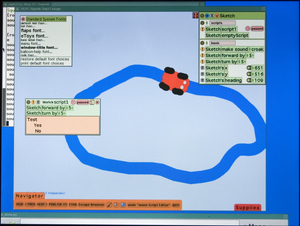
Integrated peripherals
- Keyboard: 80+ keys, 1.0mm stroke; sealed rubber-membrane key-switch assembly;
- Keyboard Layouts
- Layout pictures: English, Arabic, Thai, West African (Nigeria), Portuguese, Spanish, Amharic, French, Urdu, Cyrillic, Turkish (not final), Nepali, Mongolian, Kazakh, Devanagari, Uzbek, Pashto, Dari, Pulaar (Fula), Italian
- Gamepad: Two sets of four-direction cursor-control keys;
- Touchpad: Capacitance touchpad
- ALPS Electric Dual capacitance/resistive touchpad;
- Audio: AC’97 compatible audio subsystem; Internal stereo speakers and amplifier; internal monophonic microphone; jacks for external headphones or microphone;
- Analog Devices AD1888 and Analog Devices SSM2302 for audio amplification
- Camera: integrated color video camera; 640 x 480 resolution at 30 FPS; independent (and undefeatable by software) display of microphone and camera recording status; the camera and device driver support disabling AGC and automatic color balancing, to enable its use as a photometric sensor for educational applications;
- Wireless Networking: Integrated 802.11b/g (2.4GHz) interface; 802.11s (Mesh) networking supported; dual adjustable, rotating antennas support diversity reception; capable of mesh operation when CPU is powered down;
- Status indicators: Power, battery, and WiFi (2), visible with lid open or closed; Microphone In-Use, and Camera In-Use, visible when lid is open.
External connectors
- DC power: 6mm (1.65mm center pin) connector; 11 to 18 V input usable, –32 to +40V input tolerated; power draw limited to 17 W; - see power connector dimensions at Battery and power.
- Headphone output: standard 3.5mm 3-pin switched stereo audio jack;
- Microphone input: standard 3.5mm 2-pin switched mono microphone jack; selectable 2V DC bias; selectable sensor-input mode (DC or AC coupled);
- USB: Three Type-A USB 2.0 connectors; Up to 1A power supplied (total);
- Flash Expansion: SD Card slot.
Battery
- Pack type: 2 or 4 cells LiFePO4; or 5 cells NiMH, approx. 6V series configuration (subject to change);
- Capacity: 16.5 Watt-hours (NIMH), 22 Watt-hours (LiFeP);
- Fully-enclosed “hard” case; user removable;
- Electronics integrated with the pack provide:
- Identification;
- Battery charge and capacity monitoring chip (Maxim DS2756 data sheet);
- Thermal and over-current sensors along with cutoff switch to protect battery;
- Minimum 2,000 charge/discharge cycles (to 50% capacity of new).
- Power Management will be critical
See Laptop Batteries or more information.
BIOS/loader
- Open Firmware (including hardware initialization and fast resume).
- Panasonic ML1220 battery
Environmental specifications
- Temperature: UL certification planned to 45C in Q32007, pending 50C certification in mid-2008;
- Humidity: UL certification planned to IP42 (perhaps higher) when closed, the unit should seal well enough that children walking to and from school need not fear rainstorms and dust;
- Maximum altitude: –15m to 3048m (14.7 to 10.1 PSIA) (operating), –15m to 12192m (14.7 to 4.4 PSIA) (non-operating);
- Shock 125g, 2ms, half-sine (operating) 200g, 2ms, half-sine (non-operating);
- Random vibration: 0.75g zero-to-peak, 10Hz to 500Hz, 0.25 oct/min sweep rate (operating); 1.5g zero-to-peak, 10Hz to 500Hz, 0.5 oct/min sweep rate (nonoperating);
- 2-3mm plastic walls (1.3mm is typical for most systems).
Regulatory requirements
- The usual US and EU EMI/EMC (electromagnetic-interference and electromagnetic-compatibility) requirements will be met;
- The laptop meets IEC 60950-1, EN 60950-1, and CSA/UL 60950-1 specifications. It also complies with UL 1310 and UL 498. In order to guarantee the safety of children using the laptop, it passes ASTM F 963;
- The external power adapter complies with IEC, EN, and CSA/UL 60950-1;
- The removable battery pack complies with IEC, EN, and CSA/UL 60950-1 and UL 2054;
- RoHS (Restriction of Hazardous Substances Directive – EU) compliant.
Laptop Development Schedule
On April 15, 2006, the first prototypes of the XO, the A1 prototype boards, were first powered on. Development continued with the B1, the first complete prototype laptop, in November of 2006. The B2 laptops were the first to incorporate the CaFE chip, and was produced in small quantities for initial trials in January 2007. In April of 2008 the design was refreshed with a faster processor and more memory/NAND flash. The B3 prototypes were the first test of this design. Slight refinements were incorporated into the B4, manufactured in June 2008, which is very similar to the production version of the laptop. Finally, mass production started in November 2007 with the C2 version.
Each prototype and production version is described in more detail separately: A1, B1, B2, B3, B4, C1, C2
Serial Adapter
In order to conserve parts/space, while the motherboard does provide two serial ports for debugging (one populated in production), it does not provide voltage translators to fully implement the RS-232 protocol. Thus a 3.3V TTL to RS-232 (or USB) Adapter is needed.
Other Documents
- A complete Repair Parts List is under development.
- Schematics
See also
Formerly part of this page:
See also:
- Hardware Testing: Safety Certifications and Robustness
- Hardware
- Support
- The definitive laptop specification (only available in PDF format).
